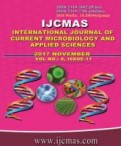


 National Academy of Agricultural Sciences (NAAS)
National Academy of Agricultural Sciences (NAAS)

|
PRINT ISSN : 2319-7692
Online ISSN : 2319-7706 Issues : 12 per year Publisher : Excellent Publishers Email : editorijcmas@gmail.com / submit@ijcmas.com Editor-in-chief: Dr.M.Prakash Index Copernicus ICV 2018: 95.39 NAAS RATING 2020: 5.38 |
Spot blotch in wheat (Bread wheat Triticum aestivum L.emend Fiori & Paol., durum wheat T. durum Derf, Khapli wheat T. dicoccum Schubl.) is mainly caused by Bipolaris sorokiniana Boerma (Sacc.) in India and neighbouring south Asian countries and capable of causing losses in yield up to 50 % in susceptible varieties as well as results poor grain quality. A total of 560 blighted leaf samples of wheat were collected from all over the India and cultures were broadly grouped in to 13 from BS 1-BS 13. The single spore cultures were later inoculated on seedlings of a differential set of genotypes, Sonalika, GW 322, HD 2733, PBW 34 and HPW 184 and incubated at 24+10C at 85-95% humidity inside polyhouse for two weeks. The host pathogen interaction was measured by taking record on incubation period, infection response (IR), number of lesions on flag-2 leaf, necrotic area developed and terminal disease severity. The differences were observed at pathogenic level also amongst isolates. Most virulent isolate was BS 4 from Faizabad in North -eastern plains zone, which produced susceptible type of infection response even on resistant genotype. It is thus concluded that 13 different types of isolates exists in case of B. sorokiniana in India.
 |
 |
 |
 |
 |